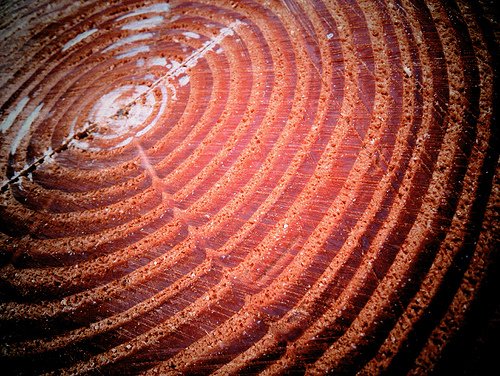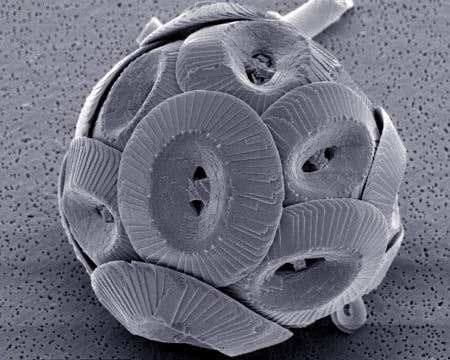Proxy Techniques: Fossils and Rocks
Tree Rings
Tree rings have been widely applied in climate reconstruction. Rings are produced as a result of seasonal variations in the growth rate of tree bark. Wood produced during rapid growth, for example in spring in temperate regions, tends to be less dense than wood produced during slower growth phases during the late summer and early autumn. Where seasonal growth is highly variable, as in temperate regions, rings are strongly etched in the bark.
As shown in the image above, tree rings are especially powerful paleo climate indicators because the number of rings can be counted to determine the age of the tree or the age of the ring that is providing paleoclimate information. The width of tree rings can be interpreted in terms of temperature and precipitation variations; however, there are a number of factors that complicate this interpretation.
Video: Tree Rings Explained (1:54)
TIM BRALOWER: Tree rings preserve an amazing inventory of Earth's climate. This photograph shows a section through part of a tree, a living tree, and it contains dozens of tree rings. An individual ring consists of a lighter part and a darker part. The lighter part is preserved, or grown, during the rapid growth season in late spring and early summer, whereas the darker part, which is made of denser wood, hence its darker color, is grown, or preserved during the latter part of the summer and the fall. Combined, the light and the dark layer preserve one annual growth cycle of the tree. Therefore, the number of rings can be counted to provide an estimate of the age of the tree. Additionally, the thickness of the ring gives us a measure of the suitability for the growth of that tree at that time.
So a thicker combination of light and dark indicates good growing conditions, such as warm temperatures and high rainfall, whereas thin rings indicate poorer growing conditions, such as colder conditions and a lower rainfall, or more arid conditions. Sometimes a tree doesn't grow at all during the year, in which case, the ring isn't preserved at all for that time period, and this would complicate using the number of rings for dating the tree. In temperate regions, tree rings are very well-preserved because the growth changes from summer to winter, whereas in tropical regions, rings are not as well-preserved because the tree is growing pretty well continuously.
Fossils
Fossils represent the remains of life that once thrived in the oceans or on land. They range in size from dinosaurs to shells of clams and oysters, all the way down to microscopic remains of algae, fractions of a millimeter in size. Although many groups of fossils can yield information on climate and environment, in this module we focus on the fossil remains of plants as well as those of the microplankton and microbenthos. These microfossils include a number of key groups that live in the ocean and in freshwater bodies such as lakes.
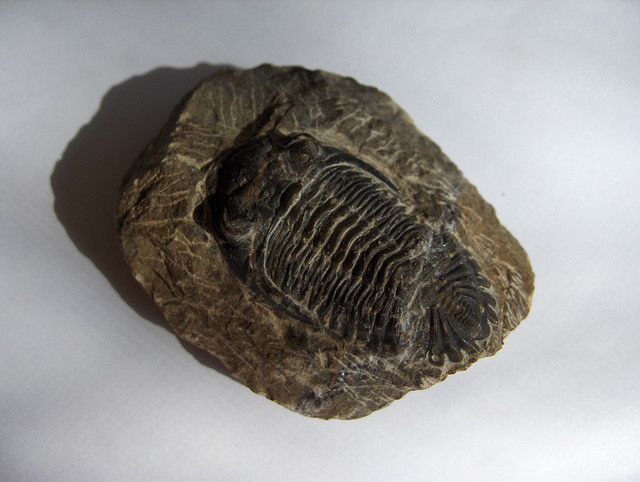
Diatoms
The diatoms are a group of plankton that makes their shell out of opal (microcrystalline SiO2). These organisms are autotrophic, meaning they fix CO2 dissolved in seawater or lake water via photosynthesis. The delicate diatom shell, or frustule, consists of two valves that fit together like a pillbox. The diatom cell lives inside the frustule and the plastids or chloroplasts use light as a source of energy in photosynthesis. Diatoms thrive where nutrient and silica levels are high: in lakes, the coastal ocean, and in the Southern Ocean, the ocean that circles the globe just north of Antarctica. Diatoms reproduce asexually (vegetatively), and, where conditions are right and nutrient levels elevated, diatoms can rapidly produce cell counts of many millions of cells per liter of seawater. In certain cases, as we will see in Module 7, these count levels are called red tides, and in some of these cases, diatoms produce toxins.
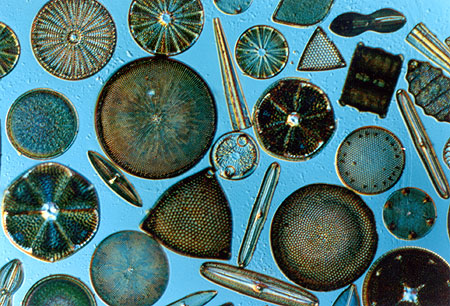
Dinoflagellates
The dinoflagellates are a group of plankton that is mostly autotrophic but can also be heterotrophic. The dinoflagellates thrive in the coastal ocean and have a complex life cycle in which a floating, motile stage alternates with a dormant resting stage. The dinoflagellates make their tests out of cellulose, which is rarely preserved; however, the cyst stage of dinoflagellates is composed of sporopollenin, a polymer that preserves readily during burial. The dinoflagellates are the group primarily responsible for red tides; we will discuss them in detail in Module 7.
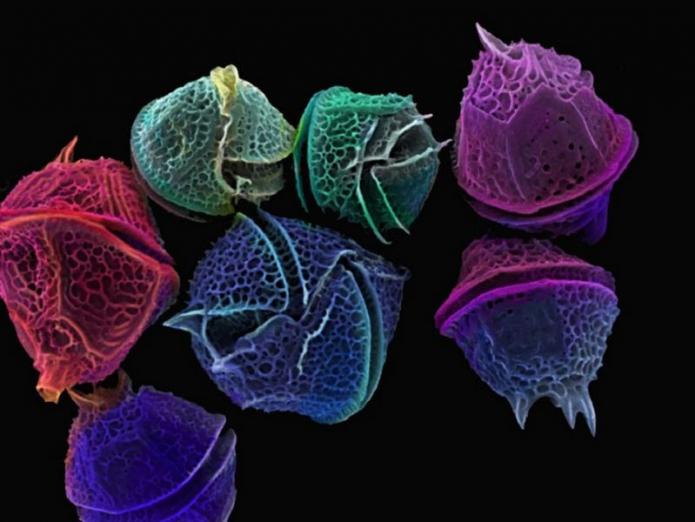
Coccolithophores
The coccolithophores, like the diatoms and dinoflagellates, are a group of marine autotrophic plankton. The coccolithophores, however, make their delicate shell out of the mineral calcite, or CaCO3, and have a more ocean-wide distribution than the diatoms. Today, the coccolithophores are adapted to live where the diatoms and dinoflagellates cannot, in parts of the ocean where nutrient levels are lower. Like the other groups, the coccolithophores are able to produce extremely large numbers of cells per liter in so-called blooms. Unlike the other two groups, the coccolithophores are threatened by ocean acidification, as we will see in Module 7.
Pictures of Foraminifera and Coccolithophores
Foraminifera
The foraminifera are zooplankton, meaning they consume tiny phytoplankton to get their energy. The foraminifera, or forams as they are known, make their shell out of calcite or CaCO3. The delicate foram shells have a variety of shapes and are adapted to the life mode of the individual species. The forams have two very different modes of life. The planktonic forams float passively in the water column, whereas the benthic forams live on the seabed, either resting on the bottom or burrowing into the soft sediment. The foraminifera have been critical in the reconstruction of ancient ocean temperatures via stable isotopes and trace element proxies, as we will see below.
The following video provides an overview of the foraminifera.
Video: Fossils and Rocks (2:10)
TIM BRALOWER: The foraminifera are a group of planktonic and benthic protists. That means they are single-celled organisms that float on the surface of the oceans or sit on the bottom of the oceans and live there. Foraminifera make their shells out of the mineral calcite (CaCo3). Planktonic foraminifera have a shell that's adapted to be buoyant in the water. Whereas benthic foraminifera have a shell that's adapted to either rest on the bottom of the ocean or burrow in the sediment. This photograph shows a planktonic foraminifera, which has a chambered shell. Individual chambers are formed and they rotate, with the outermost chamber being the chamber in which the organism inhabits.
The foraminifera extends protoplasm from its outermost chamber and this protoplasm is used to grab its prey, specifically other protists, including the coccolithophores, diatoms, and dinoflagellates. At the same time, the protoplasm actually holds zooxanthellae, which are dinoflagellates that live in a symbiotic relationship with the planktonic foraminifera. The dinoflagellates help in the calcification of the foraminiferal shell. Benthic foraminifera live on the bottom of the ocean, and they have a very strong application in providing depth information about the ancient sediments in which they're living. They also tell us about the oxygen supply on the bottom and the amount of food that's delivered through the water column. Planktonic foraminifera are most widely used in reconstructing paleo temperatures. Their shells also tell us a lot about geologic time, as their shell morphology has evolved through the course of geological history.
Radiolaria
The radiolaria are zooplankton like the foraminifera. The radiolaria are one of the longest-lived plankton groups, extending back to the early part of the Cambrian period about 500 million years before present. The group makes a spaceship-like test out of opal (SiO2) and, like the diatoms, is restricted to places in the ocean where nutrient levels are elevated. The radiolaria thrive in the tropical regions where upwelling currents bring nutrients to the surface ocean.
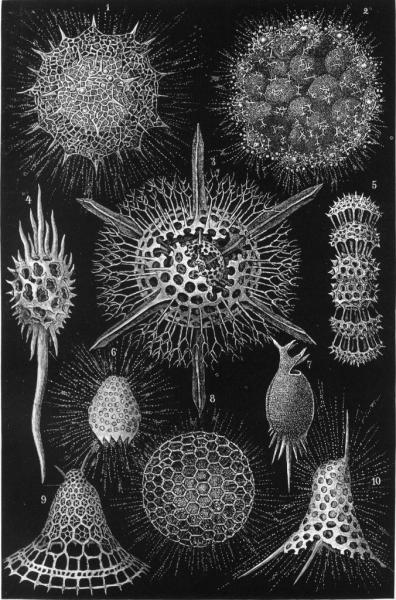
Plant Fossils
Plant fossils have been widely used in paleoclimate studies. These studies are based firmly on the distribution of modern plant species and on physical characteristics of those plants that are related to climate. The distribution of tropical plant species such as palms, cycads or groups of ferns can be used as evidence for warmer climates in the geologic record, for example, during the Cretaceous when these groups are found in places such as Alaska that have much colder climates today. Plants also provide more quantitative proxies. For example, the morphology of the margin and size of leaves is closely related to temperature and precipitation, respectively. Warmer climates tend to produce leaves that are smoother, whereas colder climates tend to produce leaves that are more jagged in shape. Wetter climates tend to produce leaves that are larger than drier climates with the same temperatures. Using the shape and size of leaves from modern locations with a range of temperatures and rainfall, equations relating margin and size to temperature and rainfall have been developed and these allow these climatic parameters to be determined from studies of ancient leaves.
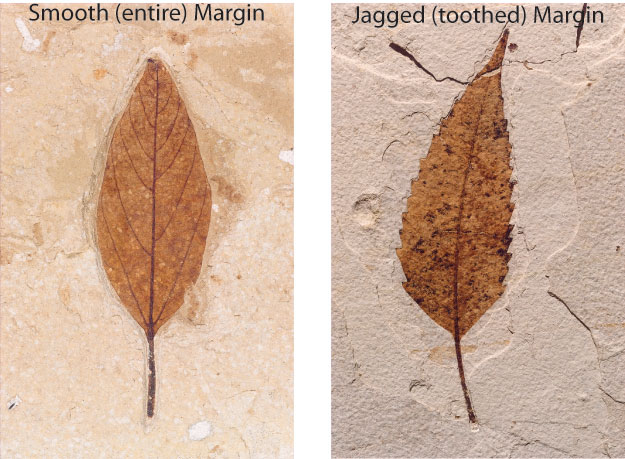
The density of the stomata, small pores typically found on the underside of leaves that provide a pathway for CO2 to enter the leaf, are related to the partial pressure of CO2. Thus stomatal density has been used as a proxy of ancient CO2
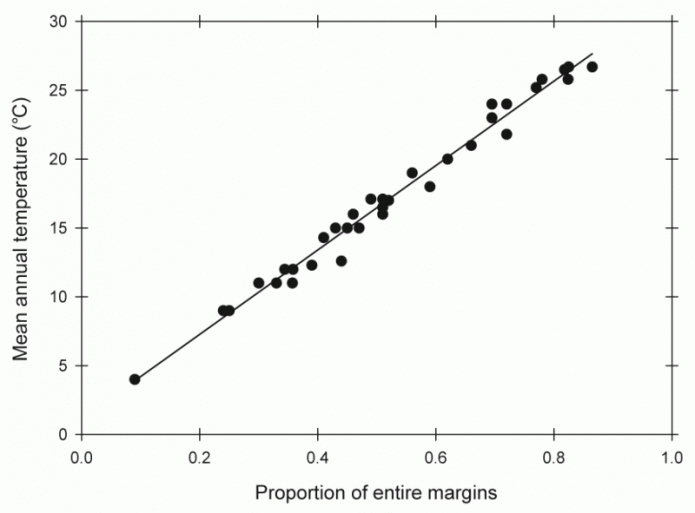
Coals/Evaporites
Certain types of sedimentary rocks are, by their very nature, indicative of certain climatic conditions. For example, in the arid subtropical regions, evaporation rates are so high that waters near the margins of the oceans readily evaporate. Once salinities reach certain levels, a sequence of minerals begins to precipitate directly from seawater. These minerals include gypsum (CaSO4H2O), anhydrite (CaSO4), dolomite (CaMg(CO3)2), halite (NaCl), and sylvite (KCl). The group of minerals is known as evaporites, and when found in the geologic record, are indicative of arid climates. Today the suite of evaporite minerals is being formed in the Persian Gulf. In the past, very thick sequences of evaporites were deposited in the Mediterranean during the late Miocene (6 million years ago), and in Texas and New Mexico during the Permian (250-300 million years ago).
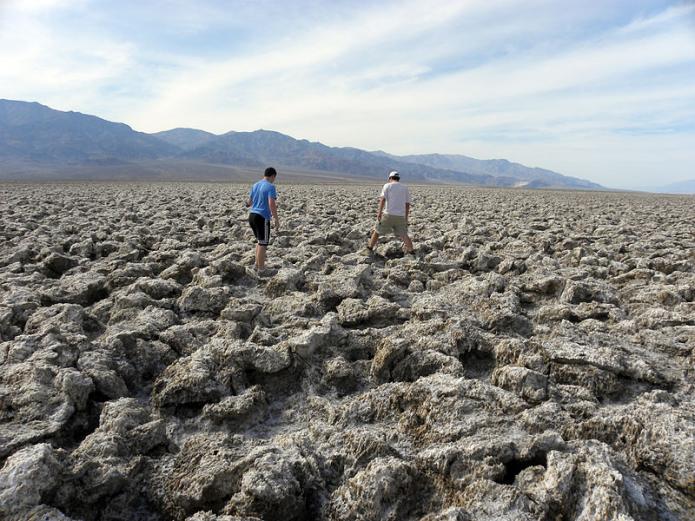
Just as evaporates indicate hot and dry climates, occurrences of coal in the geologic record suggest hot and wet climates. Today in tropical and subtropical regions with ample rainfall, trees, and other plants grow quickly. For example, tropical rainforest cover large areas in the Amazon basin, and mangrove forests grow along subtropical coasts in places like the Mississippi Delta and the coast of Florida. When this vegetation dies, it is rapidly buried in sediment in rivers, deltas, and beaches. Once encased beneath hundreds of meters of overlying sediment, and heated and pressurized over millions of years, the vegetation is transformed into coal. So just as evaporites are indicative of hot and dry conditions, coal is a sign of hot and wet conditions in the geological record. Please take a few moments to check out the photographic evidence below.
Coals and Evaporites Examples
Ancient Climate Events
In the next stage of the module, we will consider a number of climate events that took place in the geological record. The events we chose to present have one thing in common; they begin very abruptly, thus they provide some lessons about modern climate change. The events include both warming and cooling intervals and span a large part of the geologic record from over 2 billion years ago to 8.2 thousand years ago.

